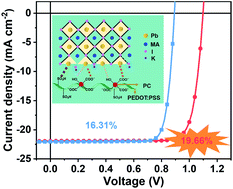Tuning interfacial chemical interaction for high-performance perovskite solar cell with PEDOT:PSS as hole transporting layer†
Abstract
PEDOT:PSS is one of the most frequently used hole transporting layer (HTL) for solution-processed optoelectronic devices, but seems unsuccessful in high-performance lead based perovskite solar cells (PVSCs) due to the high open-circuit voltage (VOC) loss as induced by the improper interfacial chemical interactions, i.e. the coordination between sulfonic group and Pb2+. To address this issue, we change this chemical interaction by incorporating potassium citrate (PC) into the PEDOT:PSS film. The PC modification significantly improves the PL intensity by nearly one order of magnitude, verifying the strong passivation effect. Accordingly, the VOC loss of MAPbI3 based inverted PVSCs is dramatically reduced by 0.23 eV, and the device performance is improved from 16.31% to 19.66%, which is among the highest PVSCs with PEDOT:PSS as HTL. Interestingly, we find the energy level alignment plays a negligible role in determining the device performance of PVSCs, while the change of interfacial chemical interaction induced passivation effect contributes to the improved device performance of PVSCs. We further unveil that the passivation effect of PC is attributed to the synergistic effect of K+ and citrate group. Our work stresses the importance of tuning the interfacial interactions, and should have implication for developing high-performance PVSCs.



 Please wait while we load your content...
Please wait while we load your content...